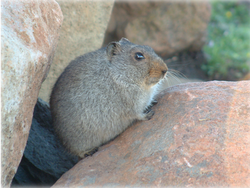Distribution and habitat
Sloggett's vlei rat is endemic to southern Africa where it occurs in southern Lesotho, the Eastern Cape as well as the western parts of KwaZulu-Natal in South Africa. It inhabits rocky habitats and alpine grassland, both wet and dry, at altitudes of more than 2,000 m (6,600 ft), and usually above 2,600 m (8,500 ft). [1]
Ecology
In suitable habitats this rodent is common; densities of over 100 animals per hectare have been observed. [3] They live in burrows, emerging during the day to forage and sun themselves on the rocks. The diet consists of the leaves, flowers and stems of green plants. In summer, the food is eaten where it is found but in winter it is mostly taken back to the burrow for consumption. Some food is also stored in the burrow, which has a complex system of tunnels and chambers and is usually occupied by a pair or a family group, of which only one female will breed. Although territorial outside the burrow, the animals will huddle together inside for warmth. They are active throughout the year but spend more time underground in winter. [3]
There may be up to a dozen entrances to the burrow, and faeces are deposited beside these. Breeding takes place in late summer, the litter size averaging 2.5 young and the gestation period being about 38 days. The young have several adaptations to the extreme cold in winter: their body, ears, limbs and tail are short compared to those of the southern African vlei rat (Otomys irroratus), reducing their heat loss, and the lactation period is long so they can remain underground until they reach a greater age. [3]
This page is based on this
Wikipedia article Text is available under the
CC BY-SA 4.0 license; additional terms may apply.
Images, videos and audio are available under their respective licenses.

